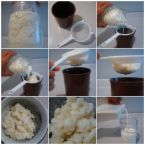Kefir is a fermented drink which has been consumed for thousands of years. It originated in the Caucasus mountains in the former Soviet Union where the drink was fermented naturally in bags made of animal hides. Its use is currently being expanded because of its unique organoleptic properties and its long tradition of health benefits.
It can be consumed as is, or can be used in cooking (in soups, sauces, and cakes). The distinctive organoleptic properties differ from yogurt in that small amounts of CO2, alcohol, and aromatic molecules are produced as a result of a dual fermentation of lactic acid bacteria and yeasts.
Although kefir is just being discovered in some areas of the world, it has been very popular in the former Soviet Union, Hungary, and Poland for many years. In the former Soviet Union, kefir accounts for 70% of the total amount of fermented milk consumed.
It is also well known in Sweden, Norway, Finland, and Germany, as well as in Greece, Austria, Brazil, and Israel. It is currently available in the United States, primarily as an ethnic drink, and is growing in popularity in Japan.
Kefir distinguishes itself from the more known fermented milk yogurt in that it is traditionally made only from kefir grains which contain a complex mixture of both bacteria and yeasts. The resulting kefir possesses unique organoleptic characteristics. Research on its health benefits is just beginning, and there remain many questions unanswered.
Two types of kefir exist: sugary, a fermented sweetened water; and milky, a fermented milk beverage. This article addresses the milky variety, whose norm has been established by the International Dairy Federation, and it will provide an overview of its characteristics and a discussion of its potential health benefits.
Sunday, March 22, 2009
Subscribe to:
Post Comments (Atom)




No comments:
Post a Comment